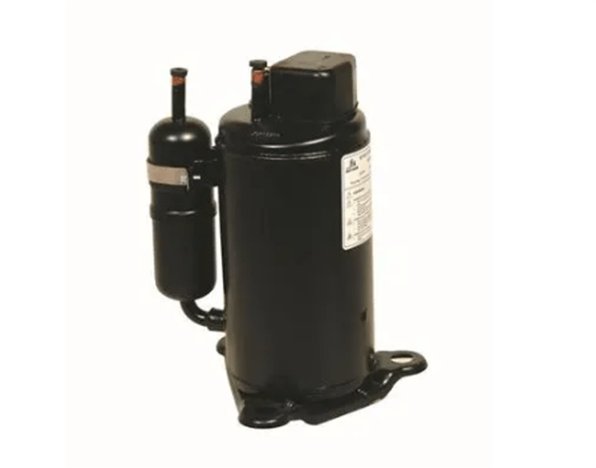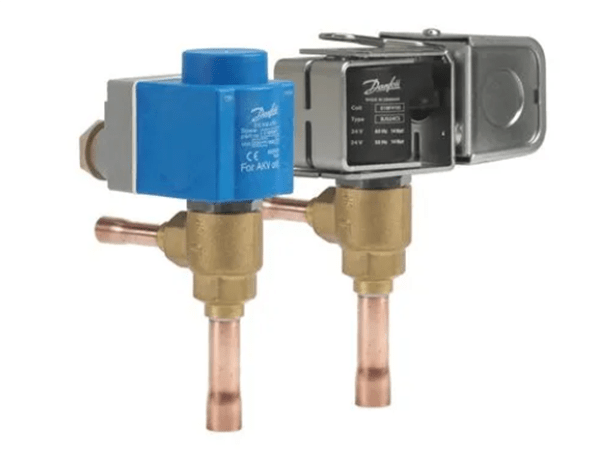
Figure 1: HVAC refrigeration cycle.
The refrigeration cycle is a cyclic process in which heat is transferred from a low-temperature object (or environment) to a high-temperature object (or environment) through a refrigerant, thereby cooling the object to a temperature lower than the environment and maintaining this low temperature. This process is realized by using a refrigeration device. The vast majority of refrigeration devices operating in the world are compression refrigeration cycles.
By reading the following, you can understand what refrigeration devices (components) are used for the refrigeration cycle, the working principle of the refrigeration cycle, refrigeration cycle diagram, etc.
1. Components of Refrigeration Cycle (Basic Refrigeration Cycle)
In the vapor compression refrigeration cycle system, the evaporator, condenser, compressor and throttling device are four essential parts (basic refrigeration cycle parts).
The evaporator is a device that transports cold. The refrigerant absorbs the heat of the object to be cooled to achieve refrigeration.

Figure 2: Evaporator.
The compressor is the heart of the whole cycle, which plays the role of sucking in, compressing, and transporting refrigerant vapor. Common refrigeration compressors include rotary compressors, reciprocating compressors, centrifugal compressors, screw compressors, etc.

Figure 3: Compressor.
The condenser is a device that releases heat, and transfers the heat absorbed in the evaporator together with the heat transformed by the work of the compressor to the cooling medium. Condensers and evaporators are both heat exchangers and are very similar in appearance.

Figure 4: Condenser.
The throttling device plays the role of throttling and reducing the pressure of the refrigerant, and at the same time controls and regulates the flow of refrigerant liquid flowing into the evaporator. Common throttling devices include thermal expansion valves, electronic expansion valves, and capillary tubes.

Figure 5: Danfoss expansion valve.
In the actual refrigeration system, in addition to the above four major basic refrigeration cycle components, there are often some auxiliary equipment, such as solenoid valves, dryers, heat collectors, pressure controllers and other components, which are set up to improve the economy, reliability and safety of operation.
In the past, most of the refrigerants used in the refrigeration cycle were chlorofluorocarbons (CFCs) with the name Freon, hydrochlorofluorocarbons (HCFCs), and ammonia. However, due to increasingly serious environmental problems, CFC and HCFC are gradually being replaced by environmentally friendly new refrigerants.
2. How Does the Refrigeration Cycle Work
Before talking about the principle of refrigeration, let's first look at some common phenomena related to refrigeration in life:
When rubbing the alcohol on the skin, you will feel cool, indicating it can cool through evaporation. Applying water to the skin also has a cooling effect, but not as pronounced as alcohol. Because alcohol evaporates more easily and faster than water, it means that the faster the evaporation, the better the refrigeration effect.

Figure 6: Evaporation and condensation process diagram.
The wet clothes are easier to dry in summer than in winter, because the temperature is high in summer and the moisture evaporates quickly. The higher the temperature, the faster the evaporation.
When boiling water on the Qinghai-Tibet Plateau, the water will boil and evaporate at 90 degrees. Because the Qinghai-Tibet Plateau has high terrain and low pressure. The lower the pressure, the faster the evaporation.
|
Temperature |
Pressure |
|||
|
|
High |
Low |
High |
Low |
|
Evaporation |
Fast |
|
|
Fast |
|
Condensation |
|
Fast |
Fast |
|
Table 1: The effect of temperature and pressure on the speed of liquid evaporation and gas condensation.
So how does the refrigeration cycle work?
2.1 Compressing
The low-temperature and low-pressure refrigerant gas from the evaporator enters the compressor and is compressed into a high-temperature and high-pressure gas. At this time, the work done by the compressor is converted into the internal energy of the refrigerant gas, which increases the temperature and pressure. This process is called an adiabatic process in thermodynamics.
Why does refrigerant gas need compressing? Because the refrigerant has to be recycled and reused. If it is not compressed, it will be directly discharged into the condenser. At this time the normal temperature is higher than the boiling point of the refrigerant, so the refrigerant cannot be cooled and condensed into a liquid.
The higher the pressure, the higher the boiling point; the lower the pressure, the lower the boiling point. Only by increasing the pressure of the refrigerant and making the freezing point (boiling point) of the refrigerant higher than the outdoor temperature, can the refrigerant dissipate heat to the outside to make the temperature drop and to condense into a liquid.

Figure 7: Air conditioning refrigeration cycle diagram.
2.2 Condensing
The high-temperature and high-pressure refrigerant gas from the compressor enters the condenser, and after the heat exchange effect of the cooling fan, it reduces the temperature and condenses into liquid refrigerant. The heat released when the refrigerant is liquefied is discharged to the outside by the cooling air. During liquefaction, the temperature of the refrigerant decreases but the pressure remains constant, which is called an isobaric process in thermodynamics.
2.3 Throttling
After the low-temperature and high-pressure refrigerant liquid coming out of the condenser flows through the thin and long capillary tube, the pressure will drop greatly, the temperature will also drop slightly, and the flow rate will also decrease. It is therefore called a throttling process. The purpose of throttling is to reduce the pressure of the refrigerant to obtain a lower evaporation temperature.
2.4 Evaporating
The low-temperature and low-pressure refrigerant liquid coming out of the capillary tube enters the evaporator and undergoes heat exchange to absorb heat, thereby evaporating from a liquid state to a gaseous state. The absorbed heat becomes the latent heat of the refrigerant. Although the temperature does not rise much, the internal energy increases a lot.
Because of the work done by the compressor, the refrigerant continuously changes from liquid to gas, thereby continuously transferring the heat in the room to the outside, so the refrigerant acts as a "porter".
3. What Happens in Refrigeration Cycle Process?
Starting from the compressor, the flow path of the refrigerant in the refrigeration cycle is: compressor→condenser→throttling device→evaporator. Therefore, there are four processes in the refrigeration cycle: compression process, condensation process, throttling process and evaporation process.
The refrigeration cycle is to repeatedly compress, condense, expand, and evaporate the limited refrigerant in a closed refrigeration system. The refrigerant continuously absorbs heat and vaporizes at the evaporator to perform cooling.
So what changes will happen to the refrigerant state, system pressure and temperature during the refrigeration cycle?

Figure 8: Refrigeration cycle diagram.
3.1 Compression Process
Occurrence location: compressor
Process description: After completing the refrigeration function, the refrigerant coming out of the evaporator is sucked into the compressor. After the refrigerant is compressed by the compressor, the temperature and pressure rise sharply.
3.2 Condensation Process
Occurrence location: condenser
Process description: The high-temperature and high-pressure gaseous refrigerant discharged from the compressor dissipates heat to the ambient air outside the condenser and becomes a high-temperature and high-pressure liquid refrigerant. This process is an exothermic process with constant pressure.
3.3 Throttling Process
Occurrence location: capillary tube
Process description: The high-temperature and high-pressure liquid refrigerant from the bottom of the condenser will decompress and expand when it flows through the throttling device, so that the pressure and temperature are reduced, and it becomes a low-temperature and low-pressure liquid and enters the evaporator.
3.4 Evaporation Process
Occurrence location: evaporator
The low-temperature and low-pressure liquid refrigerant absorbs heat from the refrigerating medium in the evaporator and then becomes a low-temperature and low-pressure gaseous refrigerant, and at the same time lowers the temperature of the refrigerating medium to achieve refrigeration. The gaseous refrigerant in the evaporator is sucked into the compressor and compressed again.
The changes that occur during the refrigeration cycle can be summarized as:
|
Components |
Refrigerant state |
Pressure change |
Temperature change |
|
Evaporator (endothermic - ambient temperature dropping) |
Liquid→Vapor |
Low pressure |
Low temperature |
|
Compressor |
Vapor→Vapor |
Low pressure→High pressure |
Low temperature→High temperature |
|
Condenser (exothermic - ambient temperature rising) |
Vapor→Liquid |
High pressure |
High temperature→Normal temperature |
|
Expansion valve (adjusting flow) |
Liquid→Liquid/Vapor |
High pressure→Low pressure |
Normal temperature→Low temperature |
Table 2: Changes happen during the refrigeration cycle.
4. Where is the Refrigeration Cycle Used?
Refrigeration cycles can move heat from one place with a lower temperature to another with a higher temperature. In daily life, the refrigeration cycle has a wide range of applications.
Refrigerators use a refrigeration cycle to maintain the temperature inside, which keeps food fresh. Air conditioners provide a comfortable environment by using the refrigeration cycle (HVAC refrigeration cycle) to lower the temperature inside the room. In addition, refrigeration cycles are also used in sports stadiums, and many industrial applications such as manufacturing, medical, telecommunications, etc.
All in all, the refrigeration cycle has a wide range of applications in life, and it can provide a comfortable environment for people, maintain the freshness of food, and be used in many industrial applications.
Related Info
Functions and Types of Condensers in Refrigeration SystemThe Difference between Hermetic and Semi-Hermetic Compressors
What is an HVAC System?
What is Vapour Compression Refrigeration System?
How Water Source Heat Pumps Work


